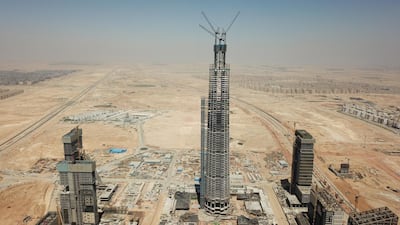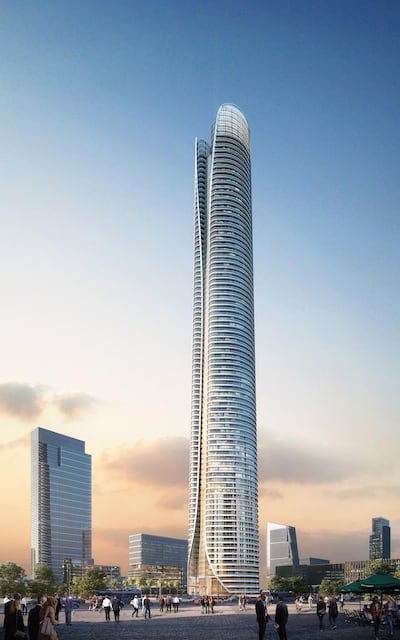Three years in the making, Africa’s tallest skyscraper has risen in the desert, 45 kilometres east of the Nile and the centre of Cairo.
The concrete structure of the 385-metre Iconic Tower was completed in June, and the steel structure is expected to be finished in August. The completed building is scheduled to be ready in the first quarter of 2022.
It will be the centrepiece among the 20 towers of the Central Business District (CBD) in the New Administrative Capital, a megaproject launched by Egyptian President Abdel Fattah El Sisi in 2015.
“This is a new era for Egypt – to enter into skyscrapers and super-tall buildings,” says Ahmed Al Banna, project manager for the CBD from Dar Al-Handasah, the designer and supervision consultant.
“The Iconic Tower itself will be the symbol and trademark for the new capital. It will show the seriousness of the government and the president to have a new capital with all the facilities.”
What is in the New Administrative Capital?
The new administrative capital – roughly the size of Singapore – is being designed as a high-tech, environmentally friendly city that includes a presidential compound, government ministries, offices, hotels, retail outlets, residential areas, sports facilities, schools and universities, a monorail, a giant park and the 35-kilometre Green River.
A main goal of the $45 billion project is to relieve congestion in Cairo, which is one of the world’s most crowded cities with a population of about 20 million, as well as create jobs and boost the economy.

The relocation of civil servants will begin in July and an official opening is planned for the end of this year, even though the first of three phases is not yet complete.
What is in the Central Business District?
The Central Business District is being built by China State Construction Engineering Corporation (CSCEC) with a $3.5 billion loan from China.
"The goal is for this to be a business hub for all of Egypt," Khaled El Husseiny, spokesman for the New Administrative Capital, tells The National.
The budget for the 81-hectare district has now reached $3.85bn, according to Al Banna.
The Green River will flow through the Capital Park at the centre of the district. There will also be two crescent-shaped buildings that will include branded apartments and retail outlets.
“The CBD itself will be a complete city,” Al Banna says.
In addition to Iconic Tower, the 20 towers being built include 12 office buildings, five residential buildings and two hotels.
Concrete work on the office towers is complete and the facade work is about 70 per cent done, while skeletal work on the residential buildings and hotels is still in progress.
“Starting from the beginning of 2022, we will hand over some office towers two by two,” Al Banna says.
The residential buildings will also be handed over in 2022, but the Iconic Tower and two hotels will only be completely ready by the first quarter of 2023.
“The finished works will be very sophisticated,” Al Banna says. “The structure will be finished, but we have a lot of internal work until we hand over.”
What will the Iconic Tower be like?
Dar Al-Handasah, an architectural firm founded in Beirut in 1956 with a principal design centre in Cairo, began work on the Iconic Tower in May 2018, with construction starting in 2019.
The project is being jointly implemented by the Egyptian Ministry of Housing, Utilities & Urban Communities and CSCEC, one of the world's largest contracting companies with about 1.62 trillion yuan ($250bn) revenue in 2020.
Built on an area of 65,000 square metres, the Iconic Tower – about half the height of the Burj Khalifa – will have 78 floors and two basement levels.
The first 40 floors will be offices, 10 will be branded apartments and 30 will be part of a five-star hotel.
There will be an observation deck on the 74th floor, where visitors can see the new capital at least 360 metres from the ground.
In comparison, the Cairo Tower – formerly the tallest building in Egypt and North Africa – is 187 metres. Elsewhere, the previous holder of the tallest building in Africa title is the 234-metre The Leonardo, a 55-floor, mixed-use property development in Johannesburg, South Africa.
What about the tower that was meant to be taller than the Burj Khalifa?
The Oblisco Capitale, a 1-kilometre tower in the shape of an Egyptian obelisk, was presented as a concept for the new capital, but it never came to fruition.
Ehab Mokhtar, managing director and chief designer at Idia Design, designed the tower at the request of El Nasr Housing & Development in 2017.
The visionary behind the project was Sayed Touba, the chief executive and chairman of the construction company, but he has since died.
The investment capital required was also a huge challenge and the Iconic Tower went ahead in the meantime.
“To have two towers at the same time coming up makes no sense for many stakeholders, so they decided to put this project on the side for a while,” Mokhtar said.
Although the project is on hold, Mokhtar said he hopes the architecture, which draws from both the Pharaonic and Art Deco styles, will inspire others.
He said the Central Business District is “more Dubai-like – which is good. But at the end of the day, it’s the new capital of Egypt, and Egypt is the source of inspiration for many things, so we should have something that shows our identity”.













